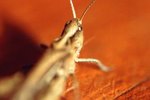
Often smaller than the birds, dogs and other predators that hunt them, lizards are equipped with a variety of defensive mechanisms to keep them alive. Whether it's the horned toad lizard or the frilled dragon, each species has a way of defending themselves. It could be something that is obvious or it may be the element of surprise that wards off a would-be predator. Either way, the results can be fascinating.
Hissing
Hissing is a common method of defense for many lizards. The hissing sound is meant as a warning to predators and is usually one of the first lines of defense. Some reptiles may combine the hissing noise with other methods to appear more dangerous to the predator. For example, the frilled dragon hisses while opening the frills around its neck.
Appearing Larger
Some lizards will puff out their throats to appear larger and more menacing, such as the bearded dragon, while others will inflate their bodies. The horned toad lizard inflates its body to the point that it appears like a spiked balloon.
Breakaway Tails
Some lizards risk life and limb, or in this case their tails, in order to escape predators. For example, the leopard gecko has a breakaway tail. If the predator has hold of the lizard's tail, the lizard can escape by allowing the tail to drop off. The tail may or may not grow back, depending on the species.
Tail Whipping
Tail whipping is a great method of defense, especially for larger lizards, such as the green iguana. Tail whipping is when the lizard lashes its tail as a means of harming the predator. Larger lizards can even break the skin of some animals.
Spines
Some lizard species are also equipped with sharp spines and spikes to make them appear more frightening to predators. Spikes can also be painful for predators that choose to bite down on the lizard. For example, the bearded dragon has spikes around the back of its head and along the sides as a form of defense.
Element of Surprise
The element of surprise is another method of defense. The blue-tongued skink sticks out its blue tongue and scares predators away by making them think it's poisonous. Another surprising defense is that of the frilled dragon, which runs on its back legs and spreads the frill around its neck to scare predators away. The horned toad lizard shoots blood from its eyes as a last defense to ward off predators.
References
Photo Credits
-
Jupiterimages/Photos.com/Getty Images
Writer Bio
Amy Brantley has been a writer since 2006, contributing to numerous online publications. She specializes in business, finance, food, decorating and pets.




